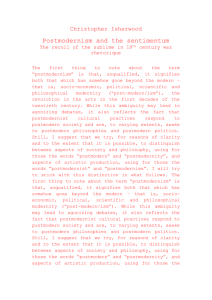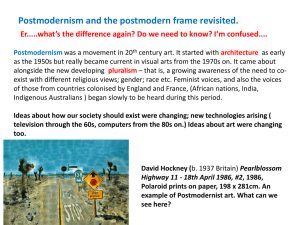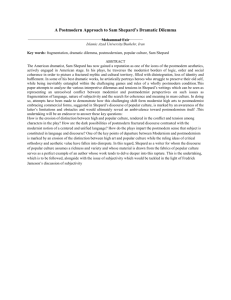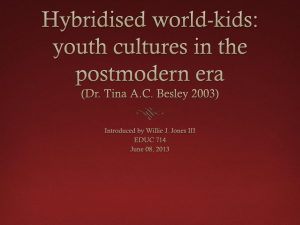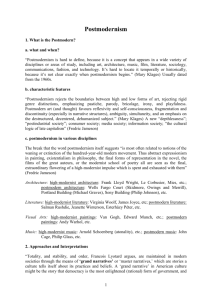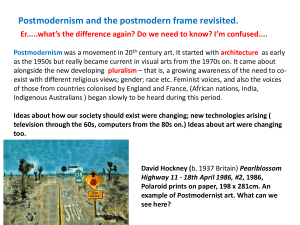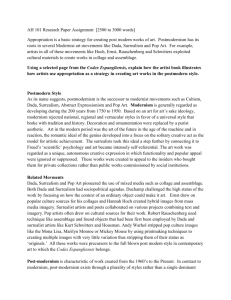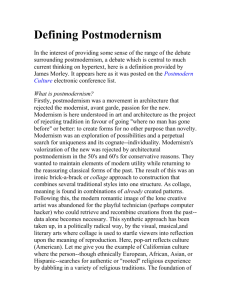Science and the environment
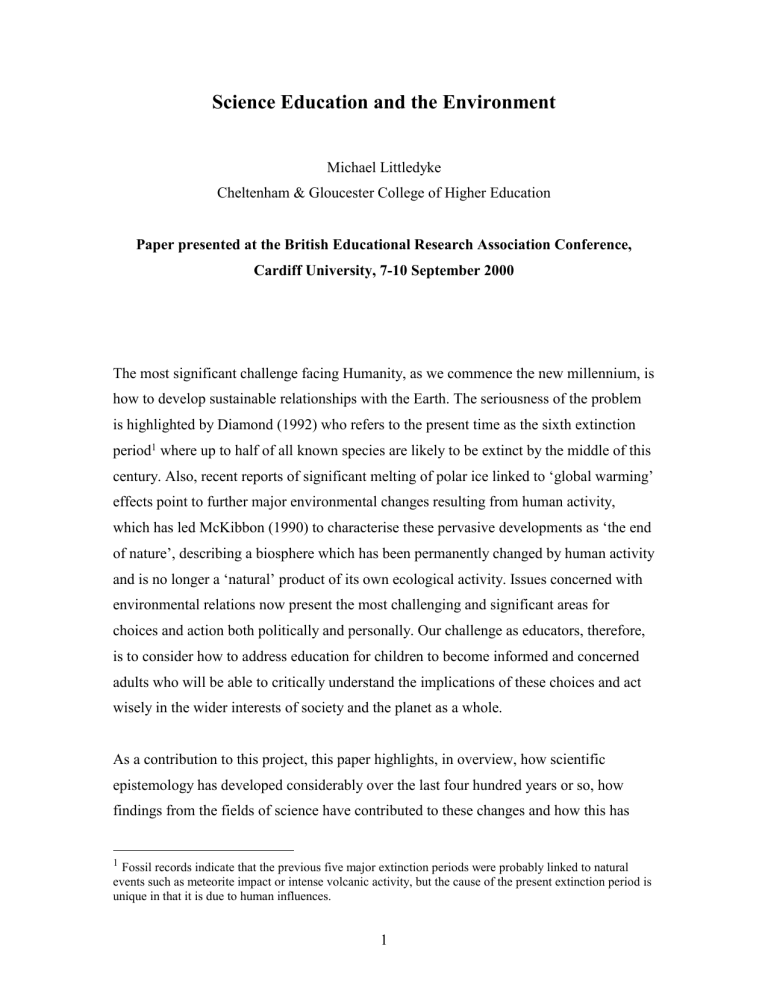
Science Education and the Environment
Michael Littledyke
Cheltenham & Gloucester College of Higher Education
Paper presented at the British Educational Research Association Conference,
Cardiff University, 7-10 September 2000
The most significant challenge facing Humanity, as we commence the new millennium, is how to develop sustainable relationships with the Earth. The seriousness of the problem is highlighted by Diamond (1992) who refers to the present time as the sixth extinction period 1 where up to half of all known species are likely to be extinct by the middle of this century. Also, recent reports of significant melting of polar ice linked to ‘global warming’ effects point to further major environmental changes resulting from human activity, which has led McKibbon (1990) to characterise these pervasive developments as ‘the end of nature’, describing a biosphere which has been permanently changed by human activity and is no longer a ‘natural’ product of its own ecological activity. Issues concerned with environmental relations now present the most challenging and significant areas for choices and action both politically and personally. Our challenge as educators, therefore, is to consider how to address education for children to become informed and concerned adults who will be able to critically understand the implications of these choices and act wisely in the wider interests of society and the planet as a whole.
As a contribution to this project, this paper highlights, in overview, how scientific epistemology has developed considerably over the last four hundred years or so, how findings from the fields of science have contributed to these changes and how this has
1
Fossil records indicate that the previous five major extinction periods were probably linked to natural events such as meteorite impact or intense volcanic activity, but the cause of the present extinction period is unique in that it is due to human influences.
1
influenced science education and perspectives on the environment. Principles are proposed to contribute to the debate concerning an agenda for an approach to science education which will support critical understanding of important environmental issues, leading to informed choice of action.
Modern and postmodern science perspectives
The terms ‘modern’ and ‘postmodern’ are widely used as way of identifying key features in philosophical and historical trends since the Renaissance period. Whilst it is difficult to find agreement about the precise meaning of the terms (Hassard 1993) it is generally understood that perspectives on science have been centrally influential to the trends.
Harvey cites a useful description of modernism, which demonstrates its scientific basis as the means to discover the ‘natural underlying rules’ of the natural world and society, so that progress can be achieved towards mastery over nature and control of society:
Generally perceived as positivistic, technocentric and rationalistic, universal modernism has been identified with the belief in linear progress, absolute truths, the rational planning of ideal social orders, and the standardisation of knowledge and production. (PRECIS 6, cited in Harvey, 1989, p. 9)
Science in the modern era, as it developed during the Enlightenment, is characterised by the following features which have had pervasive influence on society:
a search for absolute truth - a belief that all features of the universe are ultimately knowable, given the uncovering of enough scientific evidence;
rationality - in which logical thought is required to understand features of the world;
positivism - a view of the world in which rational interpretation of sense experience produces a real picture of the universe;
2
objectivity - as an essential ingredient of science, preventing contamination of sense information by emotion which could obstruct rational thought;
neutrality - linked to objectivity and presuming that dispassionate scientific judgements are inherently value-free;
exclusivity of reductive processes - which is necessary to uncover the composition and functions of the ingredients of the universe so that the whole can be understood;
mechanistic determinism - in which the various parts of the universe influence each other, hence their properties can be precisely predicted by studying the interactions;
technocentrism - where technology is dominant in society and seen as the means to achieving enhancement of human conditions;
progress - a belief that technological developments will lead to incremental improvements in conditions in societies over time.
Each of these features has been challenged by philosophical and scientific developments of the twentieth century, hence it is important to identify the limitations of the modern scientific position, as well as to indicate where postmodernism informs trends in science and environmental perspectives.
The term postmodernism is used in a wide variety of ways and applied to artistic, literary and architectural thinking as well as to philosophy. Each position seeks to overcome and transcend modernism as a world view. Lyotard, who coined the term, described it as ‘the state of our culture following the transformations which, since the end of the nineteenth century, have altered the game rules for science literature and the arts’ (1984, p. xxiii).
Within philosophical postmodernism there are two main strands:
The first strand: deconstructive or eliminative postmodernism , challenges the ingredients of a modern world view and attacks the notion of a meta-language, meta-narrative or meta-theory which explains and connects things. Thus, deconstructionists, such as
Derrida, consider that all texts are culturally influenced and involve interweavings in
‘ways we can never unravel’ and which stress ‘the indeterminacy of language’ (Harvey,
3
1989, p. 12). Others, such as Lyotard, challenge the ‘meta-narrative’ of ‘Enlightenment science ... as the bearer of emancipation’ and show how ‘as science spawns disciplines it becomes harder to maintain that they are all part of the same enterprise’ (ibid., p. 12). As the ‘traditional sense of knowledge is thus decomposed’ we are left with ‘local language games’ (ibid., p. 13).
Rorty effectively summarises the deconstructive postmodern view with his statement '... for those who espouse a post-modern perspective, reality is nothing but a temporary text constructed out of other texts' (1982, p. 15). Science, by this perspective, can be seen entirely as a human construction, a kind of contemporary myth which, arguably, has no more validity as an approach to reality than other views, religious, aesthetic, ethical or cultural, and which is bounded entirely by the rules and limitations of human communication.
However, whilst deconstructive postmodernism offers an important critique of the assumptions of modern science, it fails to undermine the project of science as an endeavour to understand features of the world through rigorous reference to evidence.
Theories and descriptions may be framed in human forms of language, but they can be tested for accuracy or otherwise in the world. This is a quite different process from myth creation, which may be entirely culturally constructed and have only symbolic relationship to features of the world (Barbour, 1966). Deconstructionists have also been criticised for creating fragmentation and incoherence; a ‘universe of nihilism where concepts float in a void’ (Hassard, 1993, p. 8); a position in which ‘life is left without truths, standards and ideals, a grim environment for the teacher’ (Kelley et al., 1998, p.
135). An alternative approach to deconstructive postmodernism is needed that acknowledges the limitations of the modern view but builds on the findings of science.
This is provided in the second postmodern strand: constructive or revisionary postmodernism, which seeks to revise modern concepts to construct:
... a new unity of scientific, ethical, aesthetic and religious institutions. It rejects not science as such but only that scientism in which the data of the modern sciences are alone allowed to contribute to the construction of our worldview. (Griffin, 1988, p. x)
4
Revisionary postmodernism asserts that features of the modern and premodern world, including scientific knowledge, must not be lost but incorporated into a new emancipatory world view which is also more ecological (Birch, 1988; Ferre; 1988) or
'organicist' (Griffin, 1988). This approach is also compatible with science as an approach to the generation of theoretical models which can be used to explain and predict phenomena (even though these models are framed within human experience, hence they cannot be said to be inviolable, absolute ‘truths').
Modern science has produced many undoubted benefits, such as in medical advances, however, it has also had socially and environmentally damaging effects, contributing to militaristic, patriarchal, anthropocentric and Eurocentric dominance (Swimme, 1988).
The precepts have been challenged by philosophical debate concerning the nature of science, which contradicts the positivism of modern science (Polanyi, 1958; Feyerabend,
1985, 1993), but also by findings from within science itself:
Epistemological criticisms of modern science
Positivism and truth
Positivism in modern science and its goal as the pursuit of absolute truth has been thoroughly discredited. In postmodern terms, knowledge has a permanent conjectural nature (Popper, 1963) and the generation of scientific knowledge takes place in a social context which influences the nature of that knowledge (Kuhn, 1970; Lakatos, 1970;
Medawar, 1979). Science is concerned with generating models which can be supported or falsified by evidence, and scientific ideas can change in time as new ideas emerge in the light of new evidence and new insights. This is summarised by Hawking:
Any physical theory is always provisional, in the sense that it is only a hypothesis: you can never prove it ... (however), you can disprove a theory by finding even a single observation that disagreed with the predictions of the theory. (1988, p. 10)
5
Positivism proposes that we sense the world directly, hence we can know it in a ‘real’ sense. However, neurophysiology shows that sense organs do not passively accept incoming data:
More neural connections run from the brain to the ear than from the ear to the brain.
And about ten percent of fibres in the optic nerve go the 'wrong way' ... The brain has to tune the organ, so it can detect what is needed. (Cohen and Stewart 1995, p. 348)
There is no such thing as naive or objective sense data. The images which we create with our brains are not like photographs or TV pictures, though they may appear like that to us.
The brain actively constructs meaning from processing incoming stimuli and previous experience through the stimulation of neural networks which are localised in specific areas (Pinker, 1995). These findings supporting the learning theory position of radical constructivism in which individuals construct personal meanings through experience
(Kelly, 1955; von Glasersfeld, 1995b), while the collective construction of scientific theory through experiment and debate within the scientific community may be thought of as an aspect of social constructivism (Vygotsky, 1962). Thus, constructivism as an underpinning theory of learning has strong support from science, just as positivism is strongly refuted (Littledyke, 1997).
Rationality, neutrality and objectivity
Monod typifies modern scientists’ support for objectivity by his statement that ‘science depends upon the postulate of objectivity’ (1972, p. 30). The assumption is that it is possible to distance feelings to produce logical, dispassionate and value free scientific judgements. However, objectivity has been shown to be illusionary and is best seen as a relative rather than an absolute position. This is confirmed by neurophysiological findings which show that logical processes and emotion are both involved during thought (Rose
1994). Thus, it is not possible to dispel the affective dimension from scientific processes, nor is it desirable, as inspiration, excitement, curiosity, a sense of wonder, as well as respect for living things, are essential ingredients in good science.
6
The scientific process has a degree of neutrality in its requirement for observable evidence to verify hypotheses, but the selection of topics for investigation and the interpretation of findings cannot be devoid of a subjective element, hence there is no such thing as neutral or value-free science. The problem of objectivity is also demonstrated strikingly by findings from quantum physics which show that matter at the quantum level cannot be understood independently of an observer, in that an experimenter can influence the outcomes of an investigation through the procedures which are chosen (Bohm, 1983).
Science is never fully objective or value-free, hence it is just as important to identify the purposes, values and implications of science activities as it is to maintain scientific rigour in the processes.
Mechanistic determinism and reductionism
Quantum physics studies indicate that matter is inherently unpredictable in a finite sense.
It is possible to provide probabilities of quantum events but it is not possible to precisely locate them temporally or spatially, hence precise determinism does not hold true.
Furthermore, evidence for non local and acausal connections between quantum events contradicts causal mechanistic determinism as a worldview. At the quantum level uncertainty, acausality and interactive field effects are better models for descriptions of phenomena (Bohm, 1983).
Findings from the newly developing field of complexity also point to the finite unpredictability of dynamic systems, with emergent order as a property of such systems and the laws of physics themselves as products of temporal change. Furthermore, ontological reductionism, in which causal effects run from parts to whole, with wholes functioning as aggregates of parts, is shown to be inadequate by evidence that whole systems have different properties from their parts and can directly influence these parts
(Kaufmann 199X). For example, genes may be influenced by the organism as a whole
(Campbell, 1985). Similarly, the 'Gaia' hypothesis of Lovelock and Margulis (Lovelock,
1979; Margulis and Sagan, 1986), which attributes a homeostatic 'self' maintaining function of the Earth, can also be viewed in this way. Furthermore Bohm's view that
'undivided wholeness implied in the content ... (and) also in the manner of working in
7
physics' (1983, p. 143) dismisses reductionism as a valid approach to understanding the deeper nature of reality as afforded by quantum physics. Reductionism has produced many valuable scientific insights, but it is clearly inadequate as an exclusive approach, as proposed by modern science.
Modern science and the environment
Technocentricity and progress
Technology, dominant in the modern era and fuelled by scientific developments, has manifest great changes responsible for benefit of human conditions, but also for environmental devastation. There has been a parallel thrust for demands for incremental progress in improvements in human living conditions. This has accentuated the scale of environmental impact, so that environmental problems, which have previously existed at containable levels throughout human history, are now threatening the existence of many species, including Homo sapiens .
Technology is not intrinsically ecologically damaging. For example, Schumacher (1973) presents a model of society in which technology supports human well being as well as ecological systems. Technologies can be specifically designed to minimise environmental impact, but ecological problems arise from the scale of technology as much as from the type. This has led so called ‘deep ecologists’ to assert that ecological problems lie essentially in relationships with and attitudes to the environment, with anthropocentrism as the core issue (Fox, 1990; Naess, 1989; Sessions, 1974; Drengson, 1989). Deep ecology as ‘the perception of reality as relationship' (Julien Puzey, cited in LaChapelle,
1991, p. 18), is seen to offer ecological sustainability. This is contrasted with 'shallow environmentalism', described by Naess (1973) as the fight against pollution and resource depletion, which he criticises as essentially resource management with anthropocentric underpinnings. In recent years the concept of ‘stewardship’ has become prominent in debates concerning environmentalism. This acknowledges the responsibility that humans have in preserving environmental quality for human benefit, but also to maintain biodiversity, which implies conserving other species for their own sakes.
8
Incremental progress as a modern assumption has been shown to be wanting in the twentieth century. Two world wars and numerous more localised wars have resulted in destruction and human casualties on an unprecedented scale in history, which calls into doubt the assumptions of progress in human societies. Neo-Darwinism also shows that evolutionary progress, a prominent nineteenth century view which assumes that humans are the pinnacle of evolutionary refinement, is inadequate to explain biological diversity, which is best seen as a ‘branching tree’ of diverse life forms with constant experimentation through natural selection and frequent extinction and development of new forms, rather than a purposeful line of development. Whilst there has been a general trend towards increasing complexity and diversity of life forms on the planet, living things in the past were just as adapted to their ecological conditions as present life forms.
Evolutionary progress and anthropocentrism, with humans as the culmination of life on
Earth, is clearly misconceived. Thus, bacteria are far more successful than any other group in their extent across the planet, while insects include some two thirds of all known animal species Homo sapiens , having existed a mere 100 000 years or so, is a newcomer to the evolutionary game and undoubtedly will be eventually superseded by these hugely successful groups (Quammen, 1997).
Objectification
Objectivity, as a central feature of modern science, distances emotion and ethics, creating the conditions for exploitation and domination. This has been a prominent feature of how science has been applied to the environment. This is characterised by Bacon, regarded as a central founder of positivist empiricism, who used images of brutality and force, as were applied in the persecutions of witches, in his scientific approach to nature when he wrote in his De Dignitate et Augementis Scientarium (1623):
The way in which witchcraft, magic, and all superstitions are prosecuted and run aground ... not only sheds useful light on how people accused of such things should be treated, but we can also borrow from it useful directions for unveiling nature's secrets.
9
No one need have scruples about penetrating these caverns and corners when interrogating the truth is his only object. (quoted in Merchant, 1980, p. 168)
In another of his works, Novum Organum (1620), he argued:
The new interrogation method leads to the analysis and dismemberment of nature. The spirit provides the suggestions and the hands do the work. In this way human knowledge and human power are one. (ibid., p. 171)
Bacon’s science called for the subjugation of nature so that its secrets would be uncovered and humanity would regain control over it. This approach has set the scene for subsequent application of science for over almost four hundred years.
The status of purpose
Modern science’s emphasis on objectivity removes purpose from the universe, so 'the more the universe seems comprehensible the more it seems pointless' (Weinberg, 1977, p.
54). The separation of feeling from relationship with nature can detract from a sense of beauty and poetry in relationship with nature, providing a bleak and abstract view of the universe. Such a view contributes to a negative image of modern science and this may be a factor in discouraging students from choosing to study (Holton 1992).
Postmodern science, which offers a humanising 'reenchantment' of science (Griffin,
1988), provides a meaningful and purposeful approach to understanding the universe in which aesthetic and spiritual relationship is central. This is also a way of making science more generally attractive and acceptable as a curriculum subject, as well as contributing to values which are necessary for the development of a sustainable society.
10
Obedience and control
Obedience and control are inevitable products of a mechanistic outlook which is central to modern practices. Obedience and control are also primary features of modern social structures. For example, Humphrey (1993) discusses how the training of soldiers involves humiliation, verbal abuse and the discrediting of the person as an individual so that he is susceptible to following orders which would, in other circumstances, would be repellent, such as killing other humans. The objectification of the enemy is an important feature if the process, thus:
Overriding all other issues is a strong racist flavour that pervades the attitude of the military ... An essential element in most massacres or atrocities is a preceding psychological step in which victims are relabelled and identified as being different, inferior or even subhuman, which allows (the soldier) to commit acts that would be unthinkable if the victims were viewed as human beings like him. (Bourne, 1971, cited in Humphrey, p. 99.)
The training of soldiers is an overt example of objectification through discipline.
However, Foucault's analysis of discipline and punishment (1977) shows how behaviour is more subtly moulded through the discipline practices of modern institutions which reflect modern values. It is through this process that large numbers of workers can become involved in environmentally destructive practices, such as polluting technologies, because they absolve themselves of responsibility for any destructive effects.
The discipline of modern science also has an important role in this process of disconnection from the consequences of action. Eagan and Orr (1992) show that modern science within a fragmented, subject oriented school curriculum reflects values which are alienated from nature. This also makes interdisciplinary studies, which are essential to understanding the scientific, social and political dimensions of environmental issues, very difficult. Such objectification processes are central in modern relationships with the environment.
11
When living things are perceived as objects to be used with no intrinsic value then permission is available to destroy them. When this attitude is also combined with anthropocentrism, where human concerns are seen to be of greatest significance, then this creates potent conditions for environmental exploitation. This view is summarised by
White (1967 cited in Fox, 1990, p. 7) when he contends that:
We deserve our increasing pollution because, according to our structure of values, so many other things have priority over achieving a viable ecology. The problem with our structure of values is that a man-nature dualism is deep rooted in us ... Until it is eradicated not only from our minds but also from our emotions, we shall doubtless be unable to make fundamental changes in our attitudes and actions affecting ecology.
Features of postmodern science
In the light of the above criticism of modern science, postmodern science, as a way of transcending the limitations of modern science, can be seen as:
• generating tentative models, which can be falsified by contradictory evidence, rather than absolute truths;
• producing ideas which are 'true' only in that they work in the terms of a particular interest;
• acknowledging that the formulation of scientific models is a human process which includes human thought;
• being non-value free and acknowledging that factors other than rational and empirical ones shape the views of the scientific community;
• producing ideas which do not exclude other views, ethical, cultural, aesthetic or religious;
• acknowledging indeterminism and probability for predictions of events, rather than precise determinism;
• emphasising internal relations and dynamic interactions in complex systems;
• emphasising interconnectedness of features of the universe, whilst celebrating its diversity;
12
• acknowledging downward causality from whole systems to their parts as well as the upward and sideways causality of reductionism;
• acknowledging the possibility of non local and acausal events as shown by findings in quantum physics;
• having social and environmental implications when scientific ideas are applied practically through technology. This implies high priority to social and environmental responsibility in the development and application of science.
This model of science reflects twentieth century scientific findings. It is also more ecological than the modern model in that dynamic relatedness is a strong feature, pointing to the interconnectedness of experience and the features of the universe and offering a synthesis of scientific and spiritual perspectives (Bohm, 1983; Capra, 1975; Cobb, 1988;
Weber, 1990). Postmodern science also offers a new synthesis of affective and effective modes in the search for understanding. In this synthesis beauty, awe and wonder as intellectual aesthetic are reawakened. This was foreshadowed by Poincare writing in
1908:
The scientist does not study nature because it is useful; he studies it because he delights in it because it is beautiful ... Of course, I do not here speak of that beauty which strikes the senses, the beauty of qualities and appearances: not that I undervalue such beauty, far from it, but it has nothing to do with science; I mean that profounder beauty which comes from the harmonious order of parts and which a pure intelligence can grasp. (1952, p. 22)
Implications for science education
Environmental education should have high priority given the seriousness of global environmental problems. Unfortunately, its status as a cross-curricular theme without clear subject status may result in it being be marginalised by the demands of the extensive knowledge centred and assessment driven content of core science and other subjects.
13
Also, many of the critical and issue based aspects relating to the environment have been located within National Curriculum geography, leaving science as concerned with scientific concept and process development, but ostensibly value free. It is all the more important, therefore, that science is taught in a way which supports the principles of postmodern science so that modern perspectives which may foster inappropriate attitudes are not perpetuated. Unfortunately, however, this is not generally the case. A number of research studies have shown that many students leave school with deficient views of science (Duveen at al., 1993; Abell and Smith, 1994; Solomon et al., 1994, 1996, Lubben and Millar, 1996; Leach et al., 1997). Also, many teachers present inauthentic models of science (Hodson, 1998), exhibit conceptual misconceptions and lack of understanding of the nature and history of science (Lakin and Wellington, 1994), which can be compounded by positivist ideas (Claydon et al., 1994; Littledyke, 1997. The prevalence of science education drawn from modern precepts within a fragmented school curriculum reflects values which are alienated from nature and can perpetuate attitudes which are environmentally damaging (Eagan and Orr, 1992; Gaskell, 1992).
There has been previous discussion of how postmodern science precepts may inform environmental education. The framework of the ideas presented here, are derived from
Littledyke (1996; 2000). The implications for education will be developed further in a subsequent paper. Hardy, also writing on this theme who shows how ‘applied investigations into chaotic systems have renounced the doctrine of objectivism and also challenged reductionism in mainstream science’ (1999, p. 126), and draws on the curriculum vision of Doll (1993), based on chaos theory, and Fien’s ideas on critical education for the environment (1993) to discuss the implications for environmental education. Other writers who call for a critical reappraisal of science education to incorporate postmodern principles include Ashley (2000), who calls for a greater need for understanding of risk and scientific uncertainty, whilst Hodson (1994) calls for the personalisation and politicisation of science to make science meaningful and to foster critical understanding of the impact of science. Payne (1999) and Gough (1999) similarly call for the personalisation of environmental education, so that personal agency can be assessed in the light of wider political agendas.
14
In the light of these critiques a curriculum agenda is required for science education which reflects postmodern science supportive of environmental education. Appropriate aims of such a curriculum are:
To develop effective modes in science:
to educate pupils into the methods and ideas of science so that they can use science to interpret and understand the world;
to assist pupils in creating meaningful personal frameworks for understanding science;
to critically analyse ideas and the application of ideas for scientific validity;
to critically evaluate the social and environmental implications of the application of scientific ideas.
To develop affective modes:
to foster a sense of interest, enjoyment and excitement in learning in science;
to include a sense of beauty, respect, reverence and awe in approaches to the environment and understanding our place in the universe.
Appropriate pedagogic strategies to achieve these aims would include:
constructivist methodology which encourages the formation of meaningful personal conceptual frameworks - this emphasises that scientific ideas must be meaningful and relevant to be of value in understanding the world;
active approaches to learning of scientific processes in which pupils themselves frame suitable questions and design and implement investigations to answer them - this shows, through direct experience, that processes of science have inherent rigour required to validate conclusions, but also that there can be a creative aspect to the selection of topics and the interpretation of findings;
application of scientific ideas to real life issues, so that the underpinning scientific ideas are made explicit, such as how understanding about the permanence of matter explains why pollution is an inevitable consequence of modern forms of technology
15
processes and how recycling can conserve resources - this can demonstrate how scientific ideas can be applied to justify protecting the environment;
emphasis on interrelationships of scientific ideas and the implications of consequences of action, such as the movement of materials through the body, or a house, to show what materials are needed, what happens to them and how health can be maintained in the body or energy conserved in a house - this illustrates how scientific understanding can inform choices of action;
where appropriate, consideration of social and ethical implications of the application of science, such as in projects which include consideration of environmental, social and impact of local or imaginary developments (Littledyke, 1998);
exposure to selected historical scientific events which involve conflict in interpretation of ideas, such as early conflicts such as Galilleo and the church, or more recent issues such as DDT, lead in petrol or genetic engineering of food- this highlights how there can be disagreement in views and how political agendas can sometimes interfere with interpretation of scientific findings;
dynamic interactive approaches to learning, such as drama, games, computer simulations which are engaging and provide opportunity for critical reflection on the ideas and their application.
Many of these suggested principles for an agenda for science education to support environmental education are acknowledged good practice and examples of teachers who apply these can be found (Littledyke, 1997). Unfortunately, there are also many examples where science teaching methods produce poor learning in science and negative and inappropriate attitudes to science which can also detract against environmental awareness.
There is clearly much work to be done through inservice and teacher education programmes, but the first steps must involve identifying inappropriate science models before positive steps can be made towards improvement.
16
References
Abell, S.K. and Smith, D.C. (1994) What is science? Preservice elementary teachers’ conceptions of the nature of science, International Journal of Science Education , 16, pp. 475-487.
Ashley, M. (2000) Science: an unreliable friend to environmental education?
Environmental Education Research , 6(3), pp. 269-280.
Barbour, I.G. (1966) Issues in Science and Religion.
London: Harpers.
Birch, C. (1988) The Postmodern Challenge to Biology, in D. R. Griffin (Ed), The
Reenchantment of Science: Postmodern Proposals.
Albany: State University of New
York Press.
Bohm, D. (1983) Wholeness and the Implicate Order. London: Ark.
Bourne, P.D. (1971) From Boot Camp to My Lai, in Falk, R. Kolko, G. & Lifton, R.
(Eds), Crimes of War . New York: Random House.
Campbell, J.H. (1985) An Organisational Interpretation of Evolution, in Depew, D.J. &
Weber, B.H. (Eds), Evolution at a Crossroads: The New Biology and the New
Philosophy of Science. Cambridge, Mass.: MIT Press.
Capra, F. (1975) The Tao of Physics. Berkeley: Shambala.
Clayden, E., Desforges, C., Mills, C. & Rawson, W. (1994) Authentic activity and learning, British Journal of Educational Studies, 60, pp. 163-173.
Cobb, J. Jr. (1988) Ecology, Science and Religion: Toward a Postmodern View, in
Griffin, D.R. (Ed) The Reenchantment of Science: Postmodern Proposals. Albany:
State University of New York Press.
Cohen, J. and Stewart, I. (1995) The Collapse of Chaos . New York: Viking.
Diamond, J. (1992) The Rise and Fall of the Third Chimpanzee: how our animal heritage affects the way we live. London: Vintage.
Doll, W.E. Jr. (1993) A Post-modern Perspective on the Curriculum . New York:
Teachers College Press.
Drengson, A.R. (1989) Beyond Environmental Crisis: From Technocratic to Planetary
Person. New York: Peter Lang.
Duveen, J. Scott, L. and Solomon, J. (1993) Pupils’ understanding of science: description of experiments or a “passion to explain”? School Science Review. 75(271), pp. 19-27.
17
Eagan, D.J. and Orr, D.W. (eds.) (1992) The Campus and Environmental Responsibility.
San Francisco, Jossey-Bass.
Fein, J. (1993) Education for the Environment: critical curriculum theorising and environmental education . Geelong: Deakin University Press.
Ferre, F. (1988) Religious World Modelling and Postmodern Science, in D. R. Griffin
(Ed) The Reenchantment of Science: Postmodern Proposals.
Albany: State University of New York Press.
Feyerabend, P. (1985) Science in a Free Society. London: Verso).
Feyerabend, P. (1993) Against Method. 3rd edition, London: Verso).
Foucault, M. (1977) Discipline and Punish: The Birth of Prison. Harmondsworth:
Penguin.
Fox, W. (1990) Toward a Transpersonal Ecology. Massachusetts: Shambala.
Gaskell, P.J. (1992) Authentic Science and School Science, International Journal of
Science Education, 14 (3), pp. 265-272.
Gough, N. (1999) Rethinking the subject: (de)constructing human agency in environmental education research. Environmental Education Research , 5(1), pp. 35-
48.
Griffin, D.R. (Ed) (1988) The Reenchantment of Science: Postmodern Proposals . Albany:
State University of New York Press.
Harvey, D. (1989) The Condition of Postmodernity. Oxford: Blackwell.
Hardy, J. (1999) Chaos in Environmental Education. Environmental Education Research ,
5(2), pp. 125-142.
Hassard, J. (1993) Postmodern and organizational analysis, in J. Hassard and M. Parker
(Eds) Postmodernism and Organization.
London: Sage.
Hawking, S.W. (1988) A Brief History of Time. London: Bantam Press.
Hodson, D. (1994) Seeking Directions for Change: the personalisation and politicisation of science education, Curriculum Studies, 2(1), pp. 71-97.
Hodson, D. (1998) Science Fiction: the continuing misrepresentation of science in the school curriculum. Curriculum Studies. 6(2), pp. 191- 216.
Holton, G. (1992) How to think about the ‘anti-science’ phenomenon . Public
Understanding of Science . 1 pp. 103-128.
18
Humphrey, N. (1993) The Inner Eye. Vintage, London.
Kaufmann, S. (1996) At Home in the Universe: the search for the laws of complexity.
London: Penguin.
Kelly, G.A. (1955) A Theory of Personality. The Psychology of Personal Constructs.
New York: W. W. Norton.
Kelley, M., Davey, H. and Haigh, N. (1998) Reflections concerning a response to postmodernism, Curriculum Studies , 6(2), pp. 133-143.
Kuhn, T. (1970) The Structure of Scientific Revolutions. Chicago: University of Chicago
Press.
Lakin, S. and Wellington, J. (1994) Who will teach the ‘nature of science’?: teachers’ views of science and their implications for science education, International Journal of
Science Education, 16, pp. 175-190.
LaChapelle, D. (1991) Educating for Deep Ecology, The Journal of Experiential
Education, 14 (3), pp. 18-22.
Lakatos, I. (1970) 'Falsification and the Methodology of Scientific Research
Programmes', in Lakatos, I. and Musgrave, A. (Eds), Criticism and the Growth of
Knowledge . Cambridge: Cambridge University Press.
Leach, J., Driver, R., Millar, R., and Scott, P. (1997) A study of progression in learning about the ‘nature of science’: issues in conceptualisation and methodology,
International Journal of Science Education , 19, pp. 147-166.
Littledyke, M. (1996) ‘Science Education for Environmental Awareness in a Postmodern
World’, Environmental Education Research 2 (2), 197-214.
Littledyke, M. (1997) 'Science education for environmental education? Primary teacher perspectives and practices', British Educational Research Journal 23 (5), 641-59.
Littledyke, M. (1998) Live Issues: Drama Strategies for Personal, Social and Moral
Education . Birmingham: Questions.
Littledyke, M., Ross, K. and Lakin, E. (2000) Science Knowledge and the Environment: a guide for students and teachers in primary education. London: David Fulton,
Lovelock, J.E. (1979) Gaia: A New Look at Life on Earth, (Oxford, Oxford University
Press).
19
Lubben, F. and Millar, R. (1996) Children’s ideas about the reliability of experimental data, International Journal of Science Education , 18, pp. 955-968.
Lyotard, J.F. (1984) The Postmodern Condition; a report on knowledge . Manchester:
Manchester University Press.
Margulis, L. and Sagan, D. (1986) Micro-Cosmos: Four Billion Years of Microbial
Evolution, (New York, Summit Books).
McKibbon, B. (1990) The End of Nature . London: Penguin.
Merchant, C. (1980) The Death of Nature: Women, Ecology and the Scientific
Revolution, (New York: Harper and Row).
Medawar, P. (1979) Is the Scientific Paper a Fraud?, London: BBC Publications, reprinted in Brown, J., Cooper, A., Horton, T, Toates, F & Zeldin, D. (Eds), Science in Schools, pp. 43-47. Milton Keynes: Open University Press.
Monod, J. (1972) Chance and Necessity. London: Collins.
Naess, A. (1973) The shallow and the deep long-range ecology movements, Inquiry, 16, pp. 95-100.
Naess, A. (1989) Ecology, Community and lifestyle: Outline of an Ecosophy. Translated and revised by Rothenberg, D. Cambridge: Cambridge University Press.
National Curriculum Council (1990) Curriculum Guidance 7: Environmental Education.
York: NCC.
Payne, P. (1999 Postmodern Challenges and Modern Horizons: education for ‘being for the environment’, Environmental Education Research , 5(1), pp. 5-34.
Pinker, S. (1998) How the Mind Works . London: Penguin.
Poincare, H. (1952) Science and Method. New York: Dover Publications. (Translated from Science and Method 1908)
Polanyi, M. (1958) Personal Knowledge. Chicago: University of Chicago Press.
Popper, K. (1963) Conjectures and Refutations. London: Routledge, Keegan and Paul.
PRECIS 6 (1987) The culture of fragment. New York: Columbia University Graduate
School of Architecture, pp. 7-24.
Quammen, D. (1997) The Song of the Dodo. London: Pimlico.
Rorty, R. (1982) Consequences of Pragmatism. Minneapolis: University of Minnesota
Press).
20
Rose, S. (1994) The Making of Memory . London: Bantam.
Schumacher, E.F. (1973) Small is Beautiful.
London: Abacus.
Sessions, G. (1974) Anthropocentrism and the Environmental Crisis, Humboldt Journal of Social Relations, 2, pp. 71-81.
Solomon, J., Duveen, J. and Scott, L. (1994) Pupils’ images of scientific epistemology,
International Journal of Science Education , 16, pp. 361-373 .
Solomon, J., Scott, L. and Duveen, J. (1996 Large-scale exploration of pupils’ understanding of the nature of science, Science Education , 16 pp. 493-508.
Steffe, L.P. and Gale, J. (Eds) (1995) Constructivism in Education. New Jersey:
Lawrence Erlbaum.
Swimme, B (1988) The Cosmic Creation Story, in Griffin, D.R. (Ed), The Reenchantment of Science: Postmodern Proposals . Albany: State University of New York Press. von Glasersfeld, E. (1995a) A Constructivist Approach to Teaching, in Steffe, L. P. and
Gale, J. (Eds) Constructivism in Education. New Jersey: Lawrence Erlbaum. von Glasersfeld, E. (1995b) Radical Constructivism: A Way of Knowing and Learning.
London: Falmer
Vygotsky, L.S. (1962) Thought and Language, Massachusetts: The M.I.T. Press.
Weber, R. (1990) Dialogues with Scientists and Sages. London: Arkana.
Weinberg, S. (1977) The First Three Minutes: A Modern View of the Origin of the
Universe. New York: Basic Books.
White, L. Jr. (1967) The Historical Roots of Our Environmental Crisis, Science , 155:
1203-7.
Dr Michael Littledyke
Research Director
Faculty of Education and Social Sciences
Cheltenham & Gloucester College of Higher Education
Cheltenham Glos. GL50 2QF
Tel.: 01242 543414/532710
Fax: 01242 532710
21
Email: mlittledyke@chelt.ac.uk
22
